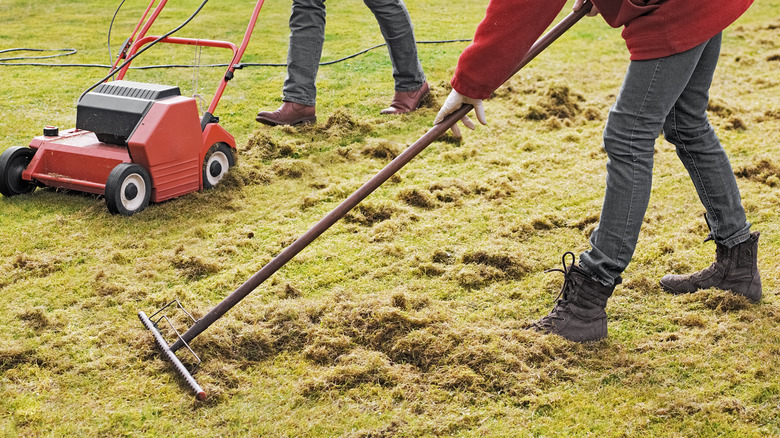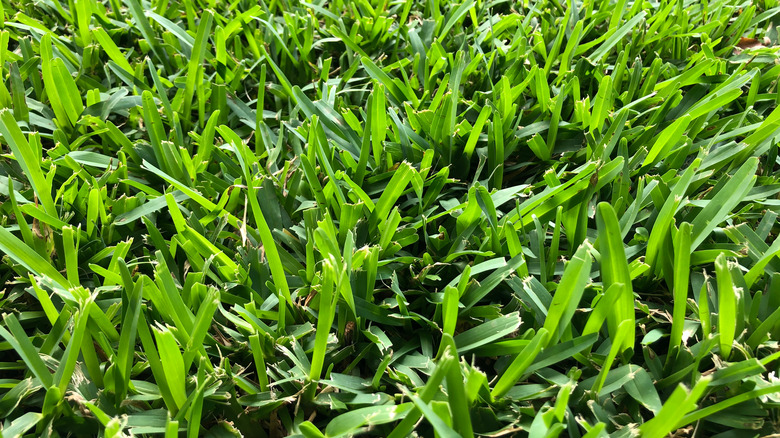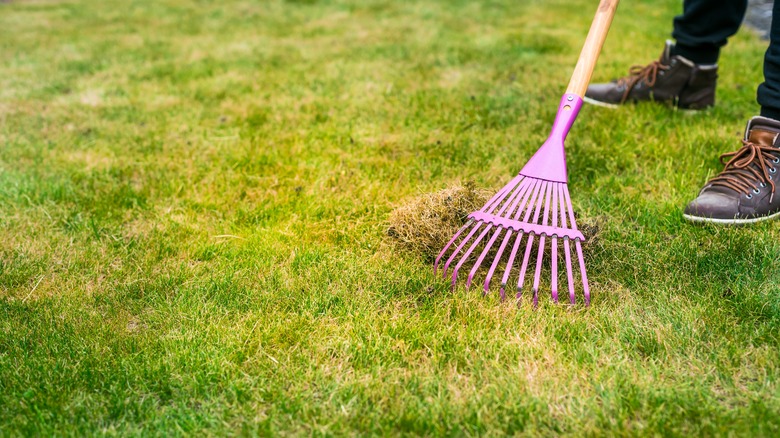Grass Types That May Be Getting Damaged By Raking
Figuring out when it's the right time to dethatch your lawn is important to maintaining its health. Removing dead grass and other debris creates more space and airflow for the grass to thrive. Dethatching your lawn involves using a hand rake or a power rake to loosen the extra material before you scoop it up, discard it, or place it on a compost pile. Because you dig along the ground's surface to remove thatch while raking, some types of grass could suffer damage from this process. A rake or power rake could harm grass plants that spread through surface runners, such as St. Augustine or centipede.
Most types of grasses spread through runners, either above ground or below ground. The above-ground runners have the most danger when exposed to the dragging of a rake that is attempting to loosen thatch. They use a creeping growth pattern to spread over the top of this soil. Eventually, it drops roots and begins growing a new plant. As the rake goes over the top of the creeping stems, also called stolon, it can pull them loose or sever them, pulling new plants out of the ground by the shallow roots or preventing the stolon from finding a new place to put down roots.
Some types, like zoysia and Bermuda, make use of both above and below-ground runners, which also can make them challenging to thatch. Kentucky bluegrass is a common type that relies on below-ground runners.
Should you rake and dethatch St. Augustine and centipede grass?
You certainly can dethatch St. Augustine and centipede grass, but it requires some special care to do the job properly without damaging the plants. The best advice with these types of lawns is to manually rake the yard when the buildup of thatch and other debris is minimal. By regularly dethatching the lawn, you'll avoid having a significant collection of extra debris that requires a power rake, which has a far higher chance of destroying the grass.
Before raking St. Augustine grass, cut the lawn to a height of about 2 inches. You normally wouldn't mow St. Augustine to lower than 2½ inches, but it's all right to mow it a bit shorter than usual when you are raking it. You should also water the yard the day before you plan to dethatch and mow, as it's easier to pull the debris loose when damp. If you simply cannot manually rake, consider using a dethatching machine rather than a power rake, as it doesn't cause as much potential damage.
To rake centipede grass, do not use a power rake. Make use of a dethatching machine or a vertical mower if you cannot use a hand rake. Do not set the blade more than ¼ of an inch in depth to minimize the damage to the above-ground runners. As with St. Augustine, aggressive dethatching could kill the centipede grass runners.
The best methods for raking and dethatching zoysia and Bermuda grasses
For types of grass that have both above and below-ground runners, you can remove thatch as long as you do it carefully. With zoysia grass, wait to attempt to remove the layer of thatch until it reaches about an inch in depth. Keeping a thin thatch layer on nearly every lawn is helpful, even for those with above or below-ground runners, as it almost acts like a layer of mulch. It helps the ground maintain its moisture levels while keeping the soil's temperature more consistent. When the layer is thick enough to attempt to remove it, the best option is to use a dethatching machine or a vertical mower with zoysia. Use a blade depth of up to ¼ of an inch while setting the blades up to 3 inches apart. A power rake is not recommended, as it is going to cause some damage to the runners above the ground on the zoysia.
With Bermuda grass, consider using a vertical mower, a dethatching machine, or a power rake. You also can manually rake it for the lowest chance of causing damage to the runners. Only use a power rake if you have no other options, as it has the highest chance of damaging Bermuda grass when dethatching. It's best to rake the Bermuda grass during the growing season in late spring and early summer so it has time to repair itself.


